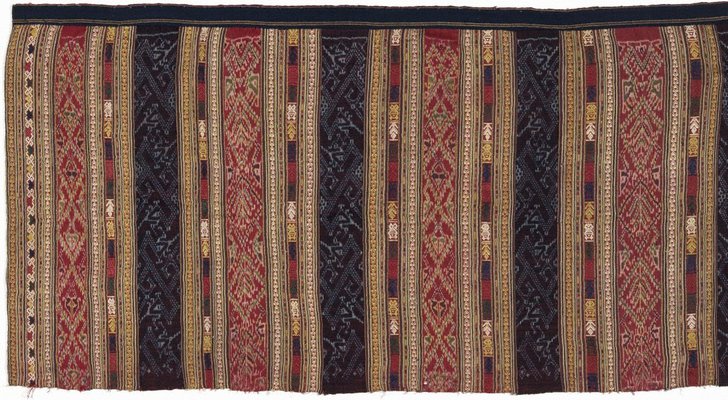

-
Details
- Other Titles
- Textile for a pha sin (ceremonial skirt) decorated with alternating panels of indigo cotton, supplementary weft decorated silk and ikat silk
Ceremonial skirt 'pha sin' - Place where the work was made
-
Northern Laos
→
Laos
- Cultural origin
- Tai Neua
- Date
- late 19th century-early 20th century
- Media category
- Textile
- Materials used
- silk, cotton, natural dyes; weft ikat with supplementary weft weave
- Dimensions
- 72.5 x 142.0 cm (irreg.)
- Credit
- Gift of Nomadic Rug Traders 2003
- Location
- Not on display
- Accession number
- 221.2003
- Copyright
- Share
-
-
About
This elaborate 'sin', or ceremonial skirt cloth, is one of the finest textiles worn by the Tai Nuea women of northern Laos. Such ceremonial skirt cloths, with their abstracted patterns based on mythical serpents, house structures and the funeral tree are used by shamans.Women also weave such textiles to give to their daughters-in-law, who then wear the skirts to the weaver’s funeral and are dressed in them for their own burials.
These skirt cloths are usually composed of three sections made of alternating bands of red silk with supplementary weft decoration however this example lacks the upper portion. Typically these cloths are indigo-dyed cotton weft ikat and red-dyed silk weft ikat. The sections of indigo-dyed cotton refer to an archaic tradition where hand-spun cotton was used to best bring out the vibrant colour of the dye. This intricately woven and dyed cloth is decorated with the traditional 'naga', or ''nak'(serpent/dragon), motif in both the indigo and red silk panel, a tree of life motif is also visible in the red silk panel.
Asian Art Department, AGNSW, July 2014
-
Bibliography
Referenced in 2 publications
-
Jackie Menzies (Editor), The Asian Collections Art Gallery of New South Wales, 'Laos', Sydney, 2003, 307 (colour illus.).
-
Susan Scollay., Hali, 'The Art of Half the World', pg. 110-111, Mar 2004-Apr 2004, 110 (colour illus.), 111. no.2
-
